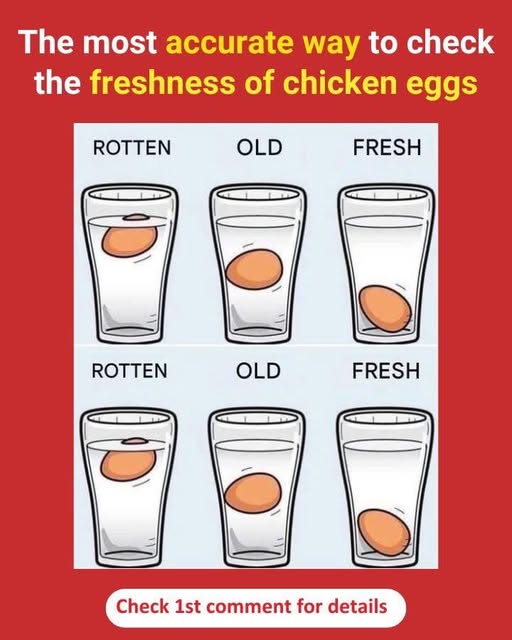The Most Accurate Way to Check the Freshness of Chicken Eggs: The Foolproof Water Test
When it comes to cooking, especially with delicate ingredients like eggs, freshness isn’t just a preference — it’s essential. Using fresh eggs is critical for flavor, texture, and, most importantly, safety. Fortunately, there’s one tried-and-true method that stands above the rest: the water test. This simple kitchen technique is not only based on solid science but also requires no special tools, making it ideal for every home cook.
Let’s dive into the most precise method to determine egg freshness, explore why it works so well, and give you a few pro tips to keep your eggs fresher, longer.
Why Egg Freshness Matters More Than You Think
Eggs may appear uniform and unchanging on the outside, but internally, significant transformations occur as they age. Over time, the contents of the egg shrink, the yolk becomes less firm, and air slowly infiltrates through microscopic pores in the shell. These changes affect:
- Texture: Fresh eggs yield firm whites and perky yolks — crucial for frying or poaching.
- Taste: Spoiled eggs emit sulfur-like odors and leave an unpleasant aftertaste.
- Safety: Old eggs can harbor bacteria like Salmonella, posing serious health risks.
Whether you’re baking soufflés or making a soft scramble, ensuring your eggs are fresh makes all the difference.
The Water Test: The Most Reliable Egg Freshness Test
What Makes the Water Test So Accurate?
As eggs age, the liquid inside begins to evaporate and is replaced with air. The more air inside the egg, the more buoyant it becomes. The water test is a visual way to measure this natural process — and it’s remarkably reliable.
Step-by-Step Guide: How to Do the Egg Water Test
🥄 Step 1: Gather What You Need
You only need three things:
- A deep bowl or glass container
- Cold water (important for accuracy)
- The eggs you want to test
Make sure your container is deep enough to allow the egg to fully submerge.
💧 Step 2: Fill the Container with Water
Fill your bowl or glass with cold water, leaving enough room for the egg to float or rest at the bottom freely. Cold water gives clearer results and slows the movement of the egg in the water for easier reading.
🥚 Step 3: Gently Add the Egg
Carefully lower an egg into the water using your hand or a spoon. Be gentle — cracking the shell could contaminate the water and ruin the test.
👁️🗨️ Step 4: Observe the Egg’s Behavior
Now, watch closely:
- Lies flat on the bottom: The egg is very fresh. Perfect for poaching, frying, or delicate baking.
- Stands upright on the bottom: The egg is still safe to eat, but it’s a few weeks old. Ideal for baking or hard-boiling.
- Floats to the top: The egg is no longer safe. Air has fully penetrated the shell, and spoilage is likely.
Visual Reference Table: Egg Freshness by Position
| Position in Water | Age Estimate | Safe to Eat? | Best Use |
|---|---|---|---|
| Lies flat on the bottom | 1–7 days old | ✅ Yes | Poaching, frying, baking |
| Stands upright on bottom | 2–3 weeks old | ✅ Yes | Hard-boiling, baking |
| Floats to the top | Over 3–4 weeks old | ❌ No | Discard immediately |
Bonus Tip: Crack It Open for Confirmation
If an egg stands or floats and you’re unsure, crack it into a bowl:
- Fresh egg: Thick white, firm and round yolk, minimal odor.
- Old egg: Runny, watery white, flat yolk.
- Spoiled egg: Thin, yellowish or greenish white, foul sulfur smell — unmistakable.
When in doubt, trust your nose.
How to Keep Your Eggs Fresher, Longer
🥶 Refrigerate Immediately
Store eggs in the coldest part of your fridge, not the door, where temperature fluctuates.
🧴 Keep Eggs in Their Carton
The carton prevents moisture loss and protects eggs from absorbing strong odors from other foods.
⬇️ Pointy Side Down
Storing eggs with the pointy end down keeps the air cell at the top, helping the yolk stay centered and the egg fresher.
📅 Track with a Marker
Write the purchase or collection date directly on the shell or carton to track age more precisely.
Why the Water Test Beats Expiration Dates
“Best by” or “sell by” dates printed on cartons can be misleading. Eggs can remain perfectly usable for weeks past these dates, depending on storage conditions. Factors such as transport time, grocery shelf life, and your fridge temperature all impact actual freshness.
The water test is based on natural egg aging, not arbitrary expiration dates, making it a real-time, science-backed solution.
Common Egg Myths – Busted!
❌ Myth: Floating eggs are always bad
Truth: While floating is a strong indicator of age, not all floating eggs are rotten — but they are no longer fresh and should be inspected carefully.
❌ Myth: Blood spots mean the egg is spoiled
Truth: Blood spots are harmless and caused by a burst vessel during formation. They do not mean the egg is bad.
Final Thoughts: Trust the Float Test for Maximum Confidence
With just a bowl of water, you can test egg freshness with scientific accuracy and zero guesswork. The water test is a time-honored method that beats expiration dates and takes less than a minute to perform.
So, next time you’re unsure about that carton in the back of the fridge, float your egg and get the answer instantly. It’s the most accurate way to protect your recipes and your health.
